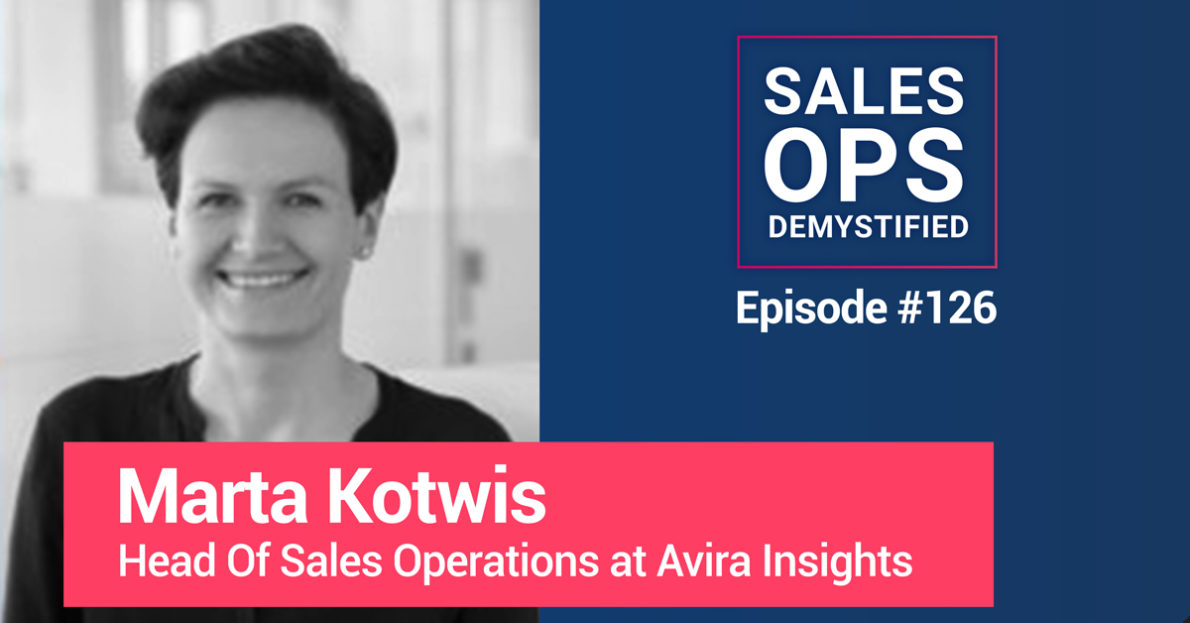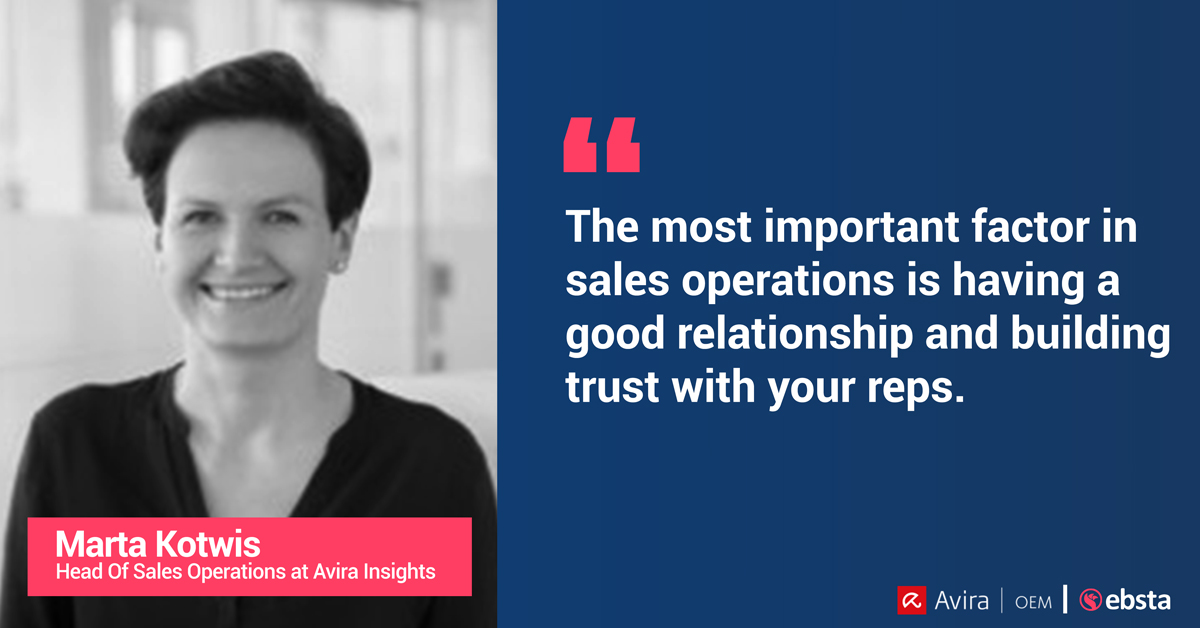
Head of Sales Operations: Marta Kotwis of Avira Insights
Marta Kotwis, head of sales operations at Avira Insights, jumped onto the Sales Ops Demystified to share her sales operations journey and experience. Check out all the other episodes of Sales Operation Demystified here.
Connect with Marta and Avira Insight here:
Tools Mentioned:
Key Takeaways
Journey into sales operations
Before joining the world of sales ops, Marta co-founded, and ran a tech startup for ten years. Marta says she learned a lot about different fields involved in running a company because while running a startup, you have to do most of the work yourself. She used to work in management and sales, and towards the end of her journey there, she also did work that could be considered sales ops work though that was not what they referred to it as.
When she left her previous job, Marta felt interested in joining the sales niche, but with more focus on development and operations than the fieldwork of sales. She joined Avira as a sales ops and strategy manager and is currently the head of sales ops. Marta has been working at Avira Insights for three years.
The team composition and tech stack being used
Marta tells us that the company has 20 sales reps divided into three regional teams across the globe. Currently, she is the only person on the sales ops team but frequently collaborates with marketing and other teams.
As far as the tech stack used for sales ops, the core of it is Salesforce. Marta is the solo Salesforce admin. They also use Tableau for data visualization. In addition to that, they use Hubspot and Sales Navigator.
Challenges in working remotely over these last few months
Their sales reps are very used to being in the field and having face-to-face meetings. So it has been a challenge to adapt to remote work. For Marta, the biggest challenge is trying to create the same relationships and a sense of trust without meeting in life and only having virtual contact. The sale cycles at Avira are usually very long. They can span from six months up to a year because of technical integration and legal issues, so it’s essential to have a good relationship with the prospective client and have a sense of trust on both ends.
Managing remote work
The first thing Avira has done is to shift all the meetings with clients to video conferences. As Marta says, it combines the ease of phone calls with the clients’ visual image so they can still pay attention to body language and try to create that type of relationship that they had been doing, way before remote work became a must-do.
Marta says she likes to let the reps themselves take the lead and go with what suits them best. Because the type of deals made at Avira can vary widely from one client to another, she doesn’t think it makes sense to have a very rigid protocol. Instead, teams focus on the specifics of their case and accordingly might choose a type of system that works for them.
Will these changes be permanent?
Marta believes it depends more on the clients. The company has settled into remote work, and there might be clients who are so used to virtual meetings that they prefer them even after the pandemic ends. However, there might be those who would want to go back to face-to-face meetings. As Marta says, whatever the client wants is going to be necessary.
How have targets been impacted?
The company is in a unique position, Marta says, because Avira’s sale cycles tend to be very long, So there has been no need to adjust the targets or objectives. She says they are keeping themselves prepared and monitoring the situation to see if the quotas need to be changed eventually, but for now, there are no changes.
One thing that she says might be affected is the number of new deals. The uncertain atmosphere because of the pandemic makes it challenging for new customers to embark on projects, but the ongoing sales are mostly unaffected.
Marta’s dynamic pipeline forecasting
Marta says the main objective is to see what is in the pipeline for different teams and use that as a guide for future forecasting. However, she acknowledges that there is no universal metric she applies across the sales team because every team has some differences due to the region in which they are working.
#1 sales metric: activity
For Marta, the most important indicator that a deal will come through is the process and activities being conducted to win the contract. She explains that by activity, she means how much work a sales rep is doing on the deal, how much communication is being done with the client, and how fast the deal moves forward. For her, this is a good indicator when it comes to very long sales cycles.
Marta’s biggest influence:
Marta tells us that she had very little official guidance when she started work, but she learns a lot from her own sales team.
Subscribe To Sales Ops Demystified:
Quote:

Table of Contents
Share this article
Sign up for Insights
Learn from the brightest minds how to predictably and efficiently grow revenue.
Related Content
Why 69% of Workers Don’t Engage & How Revenue Leaders Can Fix It
In this episode of Revenue Insights, host Adam Roberts sits down with Greg Leos, Payments Division Leader at Weave, to examine the growing trust gap between employers and employees and why it’s become a business-critical challenge for leaders in today’s workplace. With employee engagement at a decade-low and corporate leadership facing unprecedented scrutiny, Greg draws…
How High-Growth Companies Nail Sales Qualification
Want to transform your sales qualification process and close more deals? Join host Guy Rubin in this Revenue Insights greatest hits compilation, featuring standout moments from conversations with top revenue leaders at EDB, Matium, and Popl. This special episode dives deep into proven qualification methodologies like MEDDIC and Acxiom Sales Kinetics, and explores how successful…
Why Only 1 in 5 Reps Hit Quota, And How Data-Driven Leaders Fix It | Dieter Heren
In this episode of Revenue Insights, host Adam Roberts sits down with Dieter Heren, Vice President of Sales at Popl, to unpack the evolving role of revenue operations in today’s AI-first sales environment. Drawing on his rare transition from RevOps to frontline sales leadership, Dieter brings a tactical yet strategic lens to building high-performing teams…